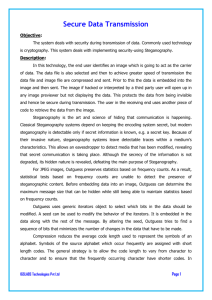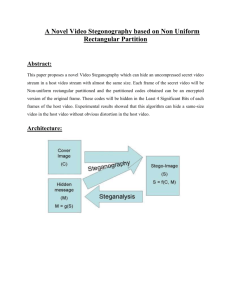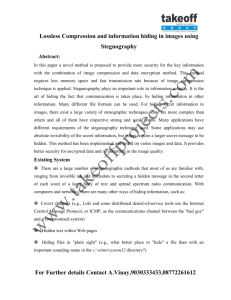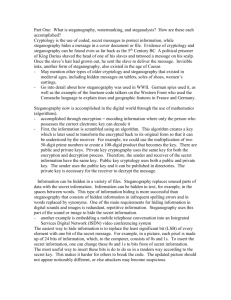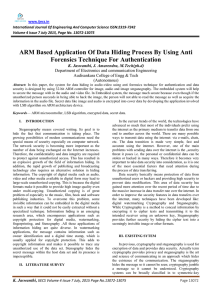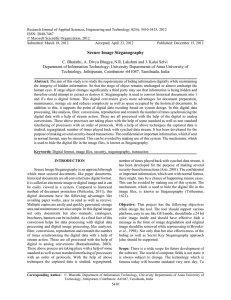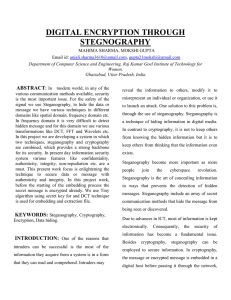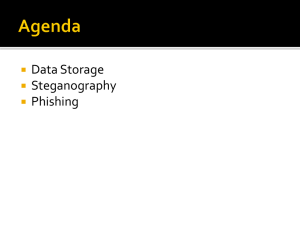CONCLUSION Steganography can protect data by
advertisement
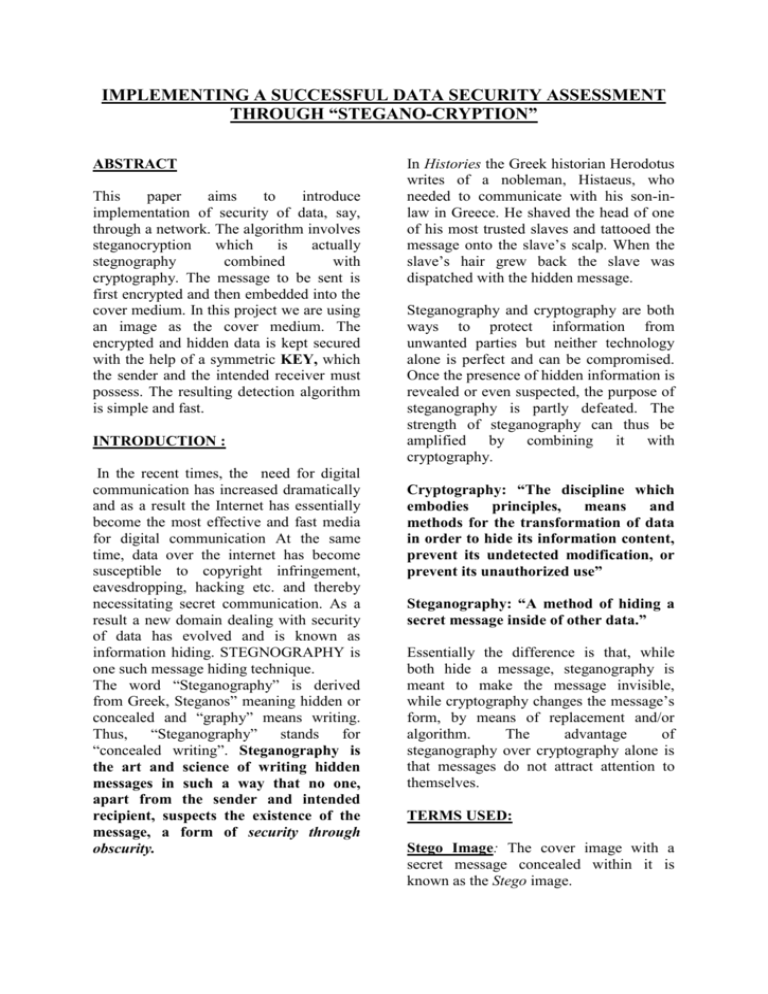
IMPLEMENTING A SUCCESSFUL DATA SECURITY ASSESSMENT THROUGH “STEGANO-CRYPTION” ABSTRACT This paper aims to introduce implementation of security of data, say, through a network. The algorithm involves steganocryption which is actually stegnography combined with cryptography. The message to be sent is first encrypted and then embedded into the cover medium. In this project we are using an image as the cover medium. The encrypted and hidden data is kept secured with the help of a symmetric KEY, which the sender and the intended receiver must possess. The resulting detection algorithm is simple and fast. INTRODUCTION : In the recent times, the need for digital communication has increased dramatically and as a result the Internet has essentially become the most effective and fast media for digital communication At the same time, data over the internet has become susceptible to copyright infringement, eavesdropping, hacking etc. and thereby necessitating secret communication. As a result a new domain dealing with security of data has evolved and is known as information hiding. STEGNOGRAPHY is one such message hiding technique. The word “Steganography” is derived from Greek, Steganos” meaning hidden or concealed and “graphy” means writing. Thus, “Steganography” stands for “concealed writing”. Steganography is the art and science of writing hidden messages in such a way that no one, apart from the sender and intended recipient, suspects the existence of the message, a form of security through obscurity. In Histories the Greek historian Herodotus writes of a nobleman, Histaeus, who needed to communicate with his son-inlaw in Greece. He shaved the head of one of his most trusted slaves and tattooed the message onto the slave’s scalp. When the slave’s hair grew back the slave was dispatched with the hidden message. Steganography and cryptography are both ways to protect information from unwanted parties but neither technology alone is perfect and can be compromised. Once the presence of hidden information is revealed or even suspected, the purpose of steganography is partly defeated. The strength of steganography can thus be amplified by combining it with cryptography. Cryptography: “The discipline which embodies principles, means and methods for the transformation of data in order to hide its information content, prevent its undetected modification, or prevent its unauthorized use” Steganography: “A method of hiding a secret message inside of other data.” Essentially the difference is that, while both hide a message, steganography is meant to make the message invisible, while cryptography changes the message’s form, by means of replacement and/or algorithm. The advantage of steganography over cryptography alone is that messages do not attract attention to themselves. TERMS USED: Stego Image: The cover image with a secret message concealed within it is known as the Stego image. Cipher text: The text received as output after cryptography that carries the secret message. Symmetric key: The same key being used at the server and the client side for encryption and decryption of the secret text respectively. algorithm adds redundancy to the hidden information and then scatters it throughout the image. A pseudorandom generator is used to select two areas of the image (or patches), patch A and patch B. All the pixels in patch A is lightened while the pixels in patch B is darkened using a constant value for alteration. EARLIER METHODS: Invisible inks prove to be a popular medium. Adding spaces and "invisible" characters to text as in HTML file. Web browsers ignore these "extra" spaces and lines, but revealing the source of the web page displays the extra characters. Operating systems store files, typically resulting in unused space that appears to be allocated to a file. The "extra" space can be used to hide information without showing up in the directory. Appending data bytes at the end of carrier: The secret data bytes are appended at the end of the carrier media such as image and the carrier media is then compressed to its original size to reduce the suspects of having secret data. Public key steganography: This method requires the pre-existence of a shared secret key to designate pixels which should be tweaked. Thus both the sender and the receiver must have this secret. Masking: Masks secret data over the original data by changing the luminance of particular areas. During masking, it embeds the message within significant bits of the cover image. Not susceptible to lossy techniques because image manipulation does not affect the secret message. Patchwork is a statistical technique that uses redundant pattern encoding to embed a message in an image. The LEAST SIGNIFICANT ALGORITHM: BIT To a computer, an image is a collection of numbers that constitute different light intensities in different areas of the image . All colour variations for the pixels of a 24bit image are derived from three primary colours: red, green and blue, and each primary colour is represented by 8 bits. In one given pixel, there can be 256 different quantities of red, green and blue, adding up to more than 16-million combinations, resulting in more than 16-million colours. Not surprisingly the larger amount of colours that can be displayed, the larger the file size. Least significant bit (LSB) insertion is a common, simple approach to embedding information in a cover image. The least significant bit (in other words, the 8th bit) of some or all of the bytes inside an image is changed to a bit of the secret messageFor example a grid for 3 pixels of a 24-bit image can be as follows: (00101101 (10100110 (11010010 00011100 11000100 10101101 11011100) 00001100) 01100011) When the number 200, which binary representation is 11001000, is embedded into the least significant bits of this part of the image, the resulting grid is as follows: (00101101 (10100110 (11010010 00011101 11000101 10101100 11011100) 00001100) 01100011) STEGANO-CRYPTION: STEGANOCRYPTION= STEGANOGRAPHY + CRYPTOGRAPHY ORIGINAL DATA ENCRYPTION ORIGINAL DATA DECRYPTION SHARED KEY ENCRYPTED DATA CIPHER TEXT STEGOSYSTEM ENCODER SEND RECEIVE STEGOSYSTEM DECODER COVER IMAGE CURRENT NEWS: As steganography continues on its evolutionary path researchers have unearthed new platforms where steganographic techniques could be employed to hide information seamlessly. Such research efforts have rekindled the research and development efforts oriented towards steganography platforms and steganalysis and a number of researchers are working towards discovering new platforms that miscreants could potentially use to hide information. For instance, researchers have shown that voice over Internet protocol (VoIP) could emerge into a popular platform for steganography owing to its ubiquity and the difficulty in detecting hidden information in VoIP streams. In addition to VoIP, platforms such as images and other multimedia content are expected to be widely used for concealing information. "Current research in steganography is focused on identifying various platforms through which one can hide information,’ notes the analyst of this research service. In the future, digital camera manufacturers could implement steganographic features as a part of camera firmware to annotate pictures with the photographer's copyright information. CONCLUSION Steganography can protect data by hiding it but using it alone may not guarantee total protection. It is possible that by using a steganocryption technique, enemy detects presence of text message in the image file and then he/she may succeed in extracting information from the picture, which can be disastrous in real life situations. This is same for plain encryption. In this case by seeing the meaningless appearing sequence of bits enemy can detect that some illegal message is being sent (unless he/she is a fool), and we may land – up in a problematic situation. However, if one uses both methods, this will lead to ‘security in depth’. The message should first be encoded using a strong encryption algorithm and then embedded into a carrier.

